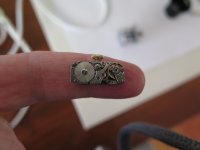Hello retro fans!
I visited local Red Cross flea market and bought a nice vintage art deco-style Mauthe mantel clock, sold in 1965.
The box's oak veneer coating had some erosion, but Osmo furniture wax fixed them easily. Mechanism is labelled W45 XXVI sno 97199
The mechanism is working and it has three bells but seems to not ring on right hour count. Any ideas before I show it to local watchsmith?



I visited local Red Cross flea market and bought a nice vintage art deco-style Mauthe mantel clock, sold in 1965.
The box's oak veneer coating had some erosion, but Osmo furniture wax fixed them easily. Mechanism is labelled W45 XXVI sno 97199
The mechanism is working and it has three bells but seems to not ring on right hour count. Any ideas before I show it to local watchsmith?


Last edited by a moderator:
This from long memories from the days I repaired them.
There's a handle somewhere that activates the hammers. Try setting the hands to, for example, 6 o'clock and
activate the handle until it strikes six times. Don't take things apart, it should work like this but you'll need to experiment a bit.
Hugo
There's a handle somewhere that activates the hammers. Try setting the hands to, for example, 6 o'clock and
activate the handle until it strikes six times. Don't take things apart, it should work like this but you'll need to experiment a bit.
Hugo
You could try try winding the minute hand quickly through the striking point. On some clocks it can cause it to skip the strike and you can get it back in sync.
Also on the few I've looked at you can move the HOUR hand back because it's a friction fit on a shaft. Which means you've another route, but if when you try it, if there's much resistance, don't push your luck.
Also on the few I've looked at you can move the HOUR hand back because it's a friction fit on a shaft. Which means you've another route, but if when you try it, if there's much resistance, don't push your luck.
I wouldn't touch the hands but manipulate the hammer handle until it 'dings' six times.Also wait for it to ding before turning the hands further.
But some experimentation is sometimes needed. Clocks tend to differ.
Hugo
Mauthe was a big manufacturer. Same mechanism was used in several models.
You can see their clocks at net auctions worldwide. Asking price for mantel clocks varies 30-700€
https://www.google.com/search?q=mauthe+mantel+clock&sca_esv=598871147&biw=1646&bih=907&tbm=shop&sxsrf=ACQVn0917HeY5MtXU4sePFth_vzrzKQ-sA:1705434368260&ei=AN2mZb__Dr2HwPAP7LGe-Ao&udm=&oq=mauthe+mantel&gs_lp=Egtwcm9kdWN0cy1jYyINbWF1dGhlIG1hbnRlbCoCCAAyChAAGIAEGBMYsANI3A9QAFgAcAB4AJABAJgBXKABXKoBATG4AQHIAQCIBgGQBgE&sclient=products-cc
You can see their clocks at net auctions worldwide. Asking price for mantel clocks varies 30-700€
https://www.google.com/search?q=mauthe+mantel+clock&sca_esv=598871147&biw=1646&bih=907&tbm=shop&sxsrf=ACQVn0917HeY5MtXU4sePFth_vzrzKQ-sA:1705434368260&ei=AN2mZb__Dr2HwPAP7LGe-Ao&udm=&oq=mauthe+mantel&gs_lp=Egtwcm9kdWN0cy1jYyINbWF1dGhlIG1hbnRlbCoCCAAyChAAGIAEGBMYsANI3A9QAFgAcAB4AJABAJgBXKABXKoBATG4AQHIAQCIBgGQBgE&sclient=products-cc
The pic was taken when wax oil was still shining. After drying and polishing it is nice and deep matte again!
I got timing corrected by turning only hour arm 3 hous back and then rotating minute arm three revolutions. Thank you Steven!
Bell has three bars and hammers. Low tone comes from both long bars being hit simultaneously.
A video taken when timing was wrong https://photos.app.goo.gl/grw5kVDf27Jmabmt7
I got timing corrected by turning only hour arm 3 hous back and then rotating minute arm three revolutions. Thank you Steven!
Bell has three bars and hammers. Low tone comes from both long bars being hit simultaneously.
A video taken when timing was wrong https://photos.app.goo.gl/grw5kVDf27Jmabmt7
Lovely clock. I have a Junghans clock with an electro/mechanical 'ATO' movement with almost exactly the same face as that.
I repair wristwatches and simple clocks for a bit of fun, but haven't worked on a decent clock with complications (other than a simple bell alarm). I wonder how hard it is? Hugo?
Here's the last watch I serviced (needing a new jewel and balance) which I found out afterwards is the equal smallest calibre made. It's my mother in law's 21st birthday present that she'd dropped and broken the balance in, many years ago. It's actually running in the photo. I know I shouldn't have my finger touching it... I got it to run circa two seconds a day, which I was happy with as I am a real amateur at this.
It was a HELL of a job pinning the hairspring with its tiny little wedge shaped stud pin and then massaging the spring so it is concentric and flat. An hour or more of intense fiddling!
I repair wristwatches and simple clocks for a bit of fun, but haven't worked on a decent clock with complications (other than a simple bell alarm). I wonder how hard it is? Hugo?
Here's the last watch I serviced (needing a new jewel and balance) which I found out afterwards is the equal smallest calibre made. It's my mother in law's 21st birthday present that she'd dropped and broken the balance in, many years ago. It's actually running in the photo. I know I shouldn't have my finger touching it... I got it to run circa two seconds a day, which I was happy with as I am a real amateur at this.
It was a HELL of a job pinning the hairspring with its tiny little wedge shaped stud pin and then massaging the spring so it is concentric and flat. An hour or more of intense fiddling!
Attachments
Last edited:
Very nice tiny watch!
It's a very rewarding job, but one needs patience and precision.
If you can repair tiny watches like these, you're doing well.
Take a look at some good YouTube watchmakers.
Here's a very skilled (and funny) guy that has the tools to tackle almost anything.
https://www.youtube.com/@RedDeadRestoration
Start practicing on simple watches and clocks and learn along the way, just as you seem to do now.
Good tools like Bergeon are not cheap but well worth the investement.
Hugo
It's a very rewarding job, but one needs patience and precision.
If you can repair tiny watches like these, you're doing well.
Take a look at some good YouTube watchmakers.
Here's a very skilled (and funny) guy that has the tools to tackle almost anything.
https://www.youtube.com/@RedDeadRestoration
Start practicing on simple watches and clocks and learn along the way, just as you seem to do now.
Good tools like Bergeon are not cheap but well worth the investement.
Hugo
Clocks are different in that every part is bigger and easier to handle.
Again the basic rules apply and taking clear pictures along the disassembling process helps a lot.
There's one big difference with electronics.
Unlike substituting obsolete transistors or other parts you can't do that with watches and clocks.
It has to be the exact original part.
Hugo
Again the basic rules apply and taking clear pictures along the disassembling process helps a lot.
There's one big difference with electronics.
Unlike substituting obsolete transistors or other parts you can't do that with watches and clocks.
It has to be the exact original part.
Hugo
Thanks Hugo. I have a reasonable set of watchmakers tools, some Bergeon. I've rebuilt about ten watches now, and service my own mechanical watches (I have a few). I am fortunate in having very steady hands. I also buy the best oils (Moebius). It's a rewarding hobby!
- Home
- Member Areas
- The Lounge
- Mauthe mechanical clocks

